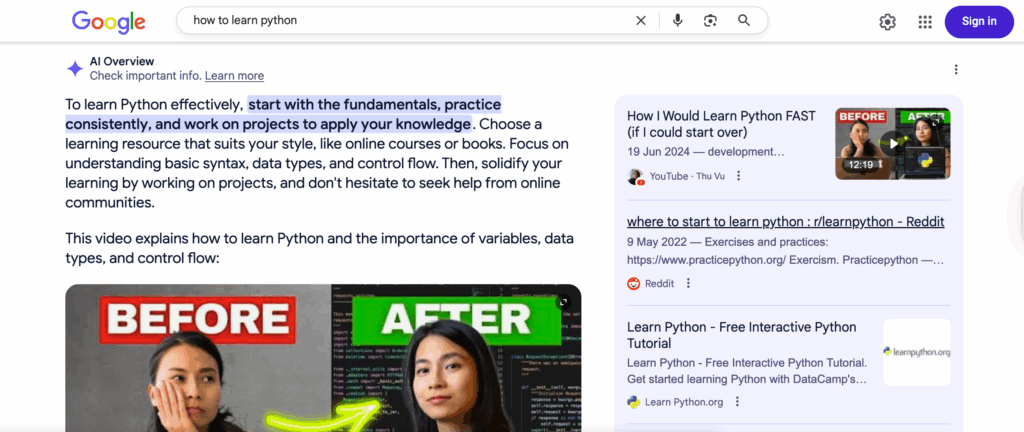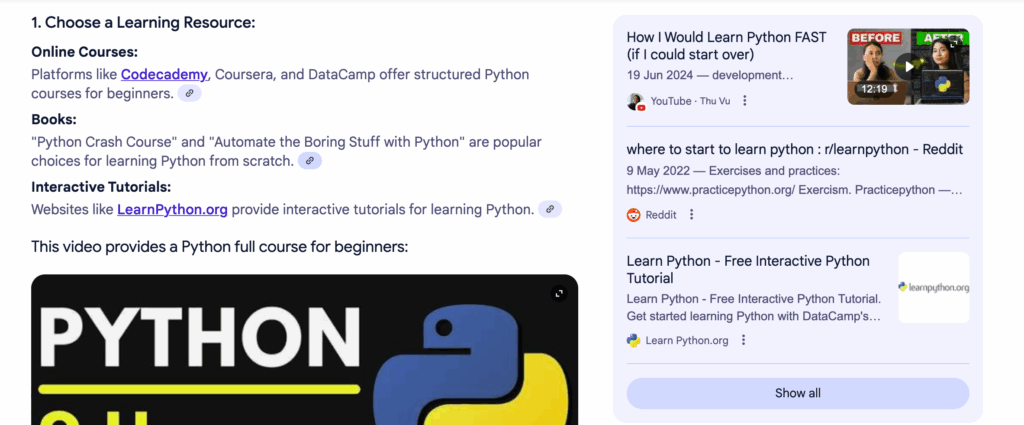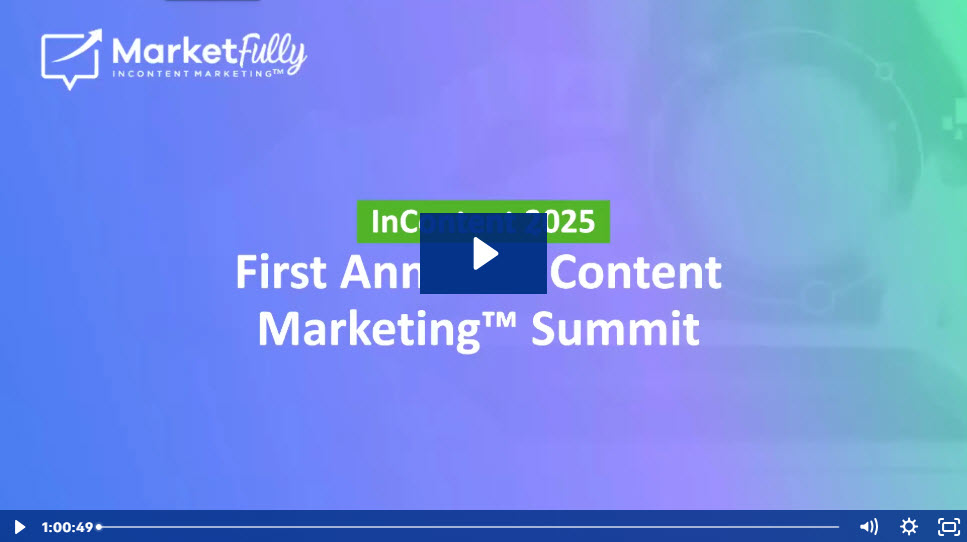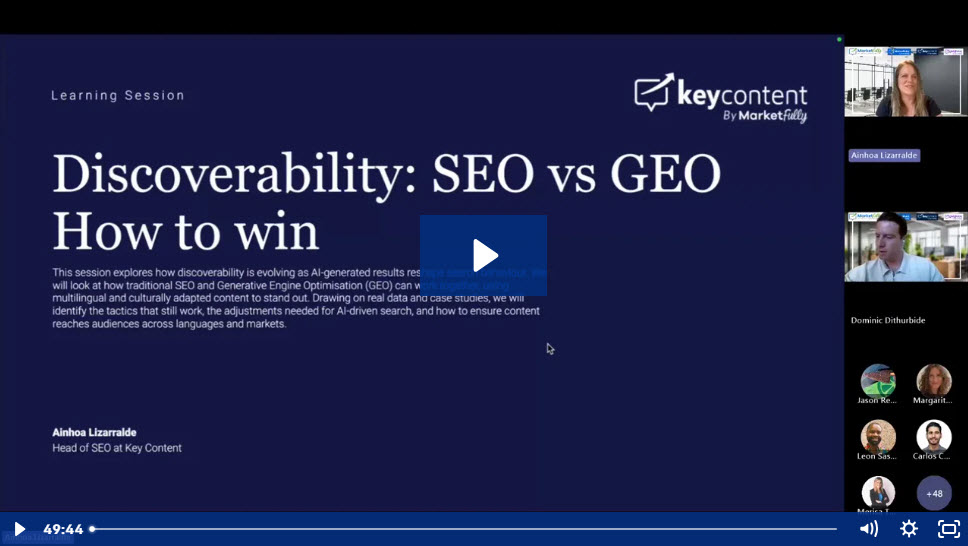Content strategies for visibility across platforms with SEO vs GEO
Although the digital landscape is fracturing across traditional search and AI-powered channels, the need for high-quality answers is still the same. Users might type a query into Google or pose it to ChatGPT today, but in both cases, they expect clear, authoritative answers.
Content now needs to serve humans and AI models. Ahrefs recently found that Google’s AI Overviews have cut click-through rates by about 34%, suggesting that many users are getting the answers they’re looking for without needing to click through.
In this changing environment, SEO and what we’ll call “GEO” (generative engine optimisation) can no longer be treated as separate silos.
SEO vs. GEO: Definitions and emerging context
Traditional SEO (Search Engine Optimisation) is the practice of creating and structuring website content to rank well on search engine results pages (SERPs). It relies on keywords, meta tags, backlinks, site speed, crawlability, and user-focused experience to drive organic traffic.
Generative Engine Optimisation (GEO) is about optimising content so that AI-powered search interfaces use it as a source when creating answers. As a recent KDD research paper explains, generative search engines find relevant documents and then use large language models to produce a consolidated answer. These AI “overviews” can then satisfy user queries on the search page and take away the need to navigate to websites by giving you a precise and comprehensive response.
Google’s rollout of “AI Mode” in May 2025 further integrates AI at the top of search results, allowing multi-step prompts and even product shopping without leaving Google.
“SEO is dead” is a narrative that’s popping up as a result, but it’s a premature one at that. Consumers still need content and expertise, but SEO tactics must adapt to the new environment. GEO doesn’t abandon SEO fundamentals, but shifts some of the focus by prioritising concise, factual answers, clear structure, and trust signals so that AI systems recognise and include the content in their outputs. Brands and CMOs must build unified strategies with classic SEO for visibility and click-throughs, while also creating content that’s optimised to be “picked up” by AI search panels.

9 SEO vs. GEO content creation tactics
Although SEO and GEO share many best practices, they differ in the way that they’re emphasised.
Here’s a comparison of the key aspects of a content strategy:
-
Content Format and Structure:
Traditional SEO favours long-form content like in-depth blog posts, comprehensive guides, or pillar pages (often 1,000+ words) that are rich with headings and details and use hierarchical headings (H1–H3), lists, images and internal links to cover a topic exhaustively.
GEO, on the other hand, values concise answers. AI Overviews pick up content that answers queries directly, so articles often benefit from a clear question–answer format or a summary at the top.
In both cases, well-organised HTML matters, and means using semantic HTML (tables, bullet lists, FAQs with schema) so AI can parse the information easily. Structured, scannable content (with clear headings, bullet points, and formatting) benefits SEO crawling and AI comprehension. -
Target Queries and Content Focus:
SEO campaigns target a mix of high-volume and brand-related queries, while GEO, by nature, relies heavily on informational, long-tail questions. Generative models shine on “how-to” or specific knowledge queries and generally provide a full answer to your question in one response.
SEO content can be narrative and comprehensive while GEO content must be precise and give clarity from the beginning. Focusing on user intent is key in both situations. Google’s recent advice is to “focus on making unique, non-commodity content that visitors… find… satisfying”. -
Content Tone and Style:
SEO’s priority is reader engagement and persuasion, so your tone can range from conversational or marketing-flavoured to formal, depending on brand voice. For GEO, a neutral, factual, and instructional tone is usually more effective, since generative AI favours clarity. Clear, accessible language in an active voice is recommended for both.
At the end of the day, the content that performs the best is unmistakably human content, with every piece highlighting real expertise and authenticity, with updated references and even embedded media to help AI “understand the context”. -
Optimisation Focus:
SEO optimisation emphasises keyword research, meta tags, backlinks, and user engagement signals, while GEO optimisation focuses on being clear and direct. Keywords still matter for discovering topics, but AI engines look for content that answers a question clearly. This means placing answers early, writing concise summaries, and using headings as cues. Schema markup (FAQs, HowTo, etc.) helps signal what parts of the page contain direct answers. Backlinks and authority are still important for overall credibility, but for an AI snippet, the immediate precision of the answer is what gets pulled.
-
Linking and Context:
Internal and external links are foundational for SEO, building site architecture and backing up claims. For GEO, links help too, but the context of links is more important. Strong internal links between related articles reinforce topical authority in Google’s eyes and also help AI build a knowledge graph. Overall, credible linking strategies strengthen the AI’s answer foundation and improves ranking potential in classic SERPs.
-
Authority Building and Authorship:
In SEO, we’ve known the importance of E-E-A-T (Experience, Expertise, Authoritativeness, Trust) for ages now. In generative search, it’s even more critical with only content from trusted experts being used. Ranktracker reports that Google’s AI Overviews “evaluate potential sources through the E-E-A-T lens” and will ignore pages that lack author bios or credible sourcing. SEO and GEO both benefit from transparent authorship, so it’s important to include author bylines with credentials, and link them to author pages or profiles.
-
Technical and Accessibility Factors:
The core technical SEO factors like fast load times, mobile-first design, correct indexing, and canonical tags are still absolutely crucial. If Google can’t crawl or index a page, neither will AI. Clean, accessible HTML is also a must for AI readability. Google’s guidelines explicitly call out content accessibility, so visible content and any structured markup must match. Alt text on images is useful for both SEO and AI comprehension.
-
Visual Elements:
Both audiences want helpful visuals, but they must be descriptive and useful rather than decorative. Include relevant images, infographics, and video to help illustrate concepts. Search Engine Land points out that charts, explainer graphics and videos “help AI understand the context better”. Any text in images must also be in HTML (AI and search engines can’t read burned-in text). Use detailed alt text and captions to describe visuals, which assist screen readers and give AI signals about content.
-
Zero-Click Adaptation:
Traditional SEO aims to maximise clicks into the site. In GEO, a zero-click outcome (user gets their answer on the search page) can still be a win. Because of this shift, it’s important that everything promotes trust and brand recognition, even snippet-worthy content. Use rich snippets or featured snippet formats (lists, tables, FAQs) so Google can easily lift and display them.
SEO still matters for SERP rankings, but we must also accept that being the source of an AI-generated answer (even without a click) is valuable. Ahrefs data confirms that pages featured in AI Overviews see large drops in click-through, but the brand name is still noted.

Making content AI-readable and uniquely valuable
To succeed in AI Overviews, content must be machine-readable and genuinely valuable. Google’s generative models scan pages for answers, but they’ll skip over content that’s unoriginal or impossible to parse. So, infuse your pages with original data, case studies, first-party research, or quotes from subject-matter experts to create new value for AI to cite.
Second, make sure you have clean, semantic formatting, using plain HTML rather than burying text in images or PDFs. Google’s guidance is clear and suggests that you match your structured data (schema markup) to the actual visible content.
Finally, focus on clarity and readability and remove any clutter (unnecessary ads or complex elements) that could confuse a scraper. A few things you can do here include, labelling tables and images with descriptive captions or alt text and giving brief summaries of longer sections to make your content “AI-friendly.”
A fused content strategy for the win
Rather than writing separate copy for each channel, create a complete strategy, with key benefits that include:
- Planning Efficiency: Teams can repurpose and adapt the same content. By building long-form, authoritative pages with built-in summaries, you can save a lot of effort. For example, a detailed guide can include a quick-answer section at the top (for AI) while the rest of the page is still comprehensive (for SEO).
- Consistent Branding: Offering one consistent message (voice, terminology, facts) across all formats is a great way to offer brand authority. Whether a user finds your content via Google or an AI chat, they should find the same expertise and data.
- Localisation: Writing once in one language and then translating misses an opportunity in GEO. Instead, localise and create content for each market with cultural context and idioms while keeping the same clear structure. Generative AIs are multilingual and often favour well-translated pages. If your English content works, the right local version can capture queries in that language. Supporting multiple languages also expands your “share of voice” in AI outputs.
- Future-Proofing: The search algorithms (Google’s and generative AI’s) continually evolve, but their core signals will always keep a focus on clarity, expertise, and user intent. A unified content strategy that includes brand-building efforts like consistent author profiles, niche expertise, and cross-links helps with SEO rankings and being cited by AI.
The goal of a unified approach is, one coherent body of work that checks all boxes, including human-friendly readability and AI-ready structure.

The role of authors and trust
Nowadays, the author of the content is almost as important s what the content says. Google’s systems heavily favour author credibility. Both SEO and AI overviews prefer content by known experts. In effect, an identifiable author or recognised expert on a subject makes your content more likely to be used.
Takeaways for authorship: Always include a byline and author bio on your content pages. List the author’s credentials (degrees, certifications, years of experience) and link to an authoritative profile (LinkedIn, professional associations, or company author page), which signals expertise and trust.
Consistency is key. Use the same author names and profiles across multiple articles to build a recognisable author brand. If possible, involve subject-matter experts (engineers, doctors, analysts), because AI systems and users trust content that demonstrates genuine experience. Key Content’s approach of “author-first” writing (with strong bios and verified quotes) aligns perfectly with these needs.
How to track success in a hybrid world
Measuring performance can be challenging when part of your traffic comes via AI channels. Traditional tools like Google Search Console, GA4, Semrush or Ahrefs still tell you about organic ranking and site traffic, but they can’t track AI-driven visibility separately. As Semrush reports, “clicks from AI Mode are not currently trackable in Google Search Console or analytics”.
To compensate, you can combine multiple methods, like:
- SEO Analytics: Continue using tools like GSC and Ahrefs for keyword rankings, traffic and CTR. If certain high-intent keywords are declining in clicks (per Ahrefs/GSC), it may indicate AI features are answering those queries.
- AI-Specific Trackers: Specialised tools are emerging to track AI, like ZipTie.dev tracking Google AI Overviews, ChatGPT, and Perplexity results by simulating queries and reporting whether your site is cited. Other tools like Knowatoa can monitor how often your brand or content appears in popular AI chat logs. These give directional insights, but can’t capture every nuance.
- Branded Query Monitoring: Run searches or prompts yourself from time to time. Ask Google’s chatbot or Perplexity about topics covered by your site and note if it cites your content. Look for mentions of your brand or unique phrases you’ve written.
- Traffic & Conversion Metrics: Measure your downstream business impact. Are you seeing conversions or inquiries that can be traced to AI sources? If ChatGPT cites your answer and a user later visits, or if branded direct traffic grows (since Google says AI answers are partly driven by brand strength), factor that into your ROI.
- Qualitative Audits: Conduct occasional manual audits. Compile a list of target questions, feed them to Google’s AI Overview and record which URLs appear.
In short and what to act on
Balancing SEO and GEO means writing content that is comprehensive but concise, authoritative and transparent, and well-structured and highly readable.
To recap the key takeaways:
- Think of search as multi-channel: Whether a user clicks a link or reads an AI snippet, the content must bring value.
- Use clear headings, lists, and schema so that content is easy for people and AI to scan.
- Prioritise E-E-A-T: Author bios, expert quotes, and unique data are more important than ever.
- Localise and create content carefully: Make sure each language version of your content is accurately translated and culturally tuned, or if it is required, created by local experts.
- Keep monitoring traditional SEO metrics (rankings, traffic) but augment with AI-specific tools and manual checks to gauge your presence in AI outputs.
- Brand building counts: Strengthening brand awareness and search intent for your brand name pays off in AI visibility.
Brands that adapt to these strategies will always have an advantage. For many global enterprises and SaaS companies, partnering with specialists can accelerate this process. Experts in multilingual, AI-aware content, like those at Key Content, can help audit your current content, make sure there’s semantic alignment across languages, and train teams in these best practices.
SEO vs GEO: Content Creation Tactics Comparison Table
| Category | SEO (Search Engine Optimisation) | GEO (Generative Engine Optimisation / AI Overviews) | Shared / Overlapping Tactics |
| Primary goal | Rank on traditional SERPs | Be featured in AI-generated summaries (AI Overviews, Perplexity, ChatGPT answers) | Increase content discoverability and visibility across search channels |
| Content format focus | Long-form pages, blog posts, category pages, FAQs | Concise, clear answers embedded in semantically rich content | Structured, scannable content with headings, bullets, lists |
| Query types targeted | High to medium-volume keywords; mix of intent types | Long-tail, low-volume, informational queries | Informational and how-to content is essential for both |
| Structure | Hierarchical headings (H1–H3), internal linking, meta tags | Direct answers early in page, question–answer structure, featured snippets-style formatting | Semantic HTML, subheadings, concise summaries per section |
| Content length | Often long-form, detailed (1000–2500 words) | Short-form, fact-based, summarised early in page | Depth with clarity: comprehensive but scannable |
| Optimisation focus | Keywords, meta tags, backlinking, CTR optimisation | Clarity of expression, directness, summarisation potential | Intent matching and answer precision |
| Performance tracking | GSC, GA4, Semrush, Ahrefs (rank, traffic, CTR) | Manual monitoring, experimental tools (AI Overview trackers) | Blend of analytics + qualitative visibility reviews |
| Authority building | E-E-A-T (with backlinks, author bios, SME quotes) | E-E-A-T + brand mentions + author consistency across platforms | Transparent authorship, trust signals, SME quotes |
| Content tone/style | Natural language, often marketing-influenced | Neutral, factual, often instructional | Clear, accessible language, active voice |
| Linking strategy | Strong internal links, external references for credibility | Internal anchor context helps AI summarise and extract meaning | Topical linking and context clues around entities |
| Multilingual/local content | Localised keywords, hreflang, translated/optimised pages | AI may infer multilingual relevance if content is clearly marked | Regional versions must preserve clarity and semantic alignment |
| Technical SEO relevance | Crucial (indexability, crawlability, page speed, canonicalisation) | Indirect but still relevant – indexation errors reduce visibility in source rankings | Clean HTML, accessible layout, fast-loading mobile-first design |
| Visual elements | Alt text, schema markup, images and infographics for UX | Alt text and semantic clarity may influence AI comprehension | Descriptive, useful media (not decorative) aids both |
| Adaptability to zero-click | SEO still aims for click-through; structured data supports snippets | GEO accepts and supports zero-click content as success | Featured snippets and summaries must offer enough value to build brand visibility |
| Content format accessibility | Can use mixed formats (PDFs, infographics, visuals) if well optimised | Prefers structured, parseable formats like HTML tables, bullet lists, FAQ blocks | Prioritise HTML-native formats; avoid text in images; use schema for clarity |







